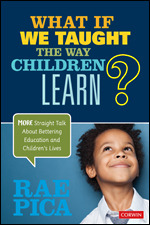What If We Taught the Way Children Learn?
More Straight Talk About Bettering Education and Children's Lives
- Rae Pica - Education Consultant
Strengthen the connection between child development and learning
We often teach our children in ways contrary to what we know about their development. What if our learning environments honored children’s natural inclinations and used them to enrich their lives? To help students experience joy and discovery, while also preparing them for future schooling, we need to understand the connection between how they develop and how they learn. Pica brings decades of experience in education to advocate for this change.
Written as a follow-up to the bestselling What If Everybody Understood Child Development?, this book includes:
- 31 easy-to-read chapters on topics including disruptive behavior, creativity, self-regulation, screen time, and mental health
- Suggested next steps and resources in every chapter
- Real-life examples from the author's and others’ experiences
- Evidence from brain science research
- Easy-to-read format perfect for PLCs, book studies, and parents
The straight talk in this book inspires readers to generate change so that children can have the lives and education they deserve.
"Rae Pica’s powerful, thought-provoking book provides rare and uncommon sense. This should be mandatory reading for all new teachers. Our kids would be MUCH better off if we practiced the way that this book suggests we do, and so would the educators around them.”
"There is a documented rise in challenging behaviors in classrooms and schools nationwide. We, as educators, are the 'front line.' We need to analyze our interactions with our students and work diligently to provide them with the most appropriate education possible. For our youngest learners, the importance of movement and play cannot be overlooked, minimized, or marginalized. This book helps to easily identify what is is occurring in classrooms today and provides meaningful, easy-to-implement ways to make necessary adjustments to address this crisis."
"I've been impatiently awaiting Rae Pica's new book since I finished her last one! Few people understand children, parents, and educators the way she does. Rae is a passionate advocate, courageous champion, and creative teacher and mentor, with the ability to convey her wisdom both clearly and persuasively. What If We Taught the Way Children Learn? We would have a world in which children and adults collaborate to shape a better tomorrow. This book belongs on the shelf of anyone who cares about what it means to be truly educated."
"Rae Pica’s simple yet powerful statement touched my heart: 'Children really aren’t complicated. All they want and need is you.' Anyone who has worked in an early childhood classroom over the past ten years can tell you that teaching today has become much more complicated, but it shouldn’t be that way and it doesn’t have to be. Rae has brilliantly designed each chapter of her book to clearly identify a specific challenge that is complicating the abilities of early educators to inspire and build on a young child’s natural love for learning. She gives her readers the why, what, and where: why the challenges in today’s classrooms are significantly more difficult; what can be done to make an immediate and positive difference inside the classroom; and where to find research-based resources that can be used to advocate for change in policies or false beliefs affecting today’s early childhood classrooms. What If We Taught the Way Children Learn will give early childhood teachers the confidence and support they need to have a voice regarding the issues that are complicating early learning in their classrooms. This is a must read and a brilliant resource for any early childhood educator who wants to make a genuine difference."
"I highly recommend this book as required reading for every teacher and preservice teacher (and parents too!) The topics discussed in this book make you take a step back and think about current teaching practices and why we do them."

